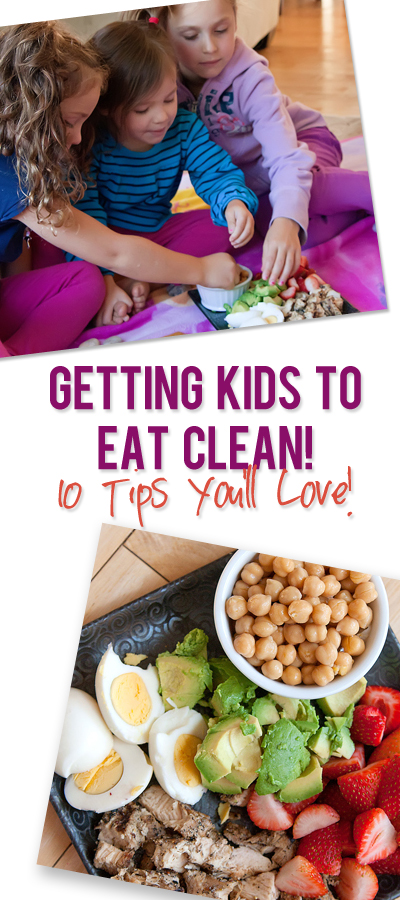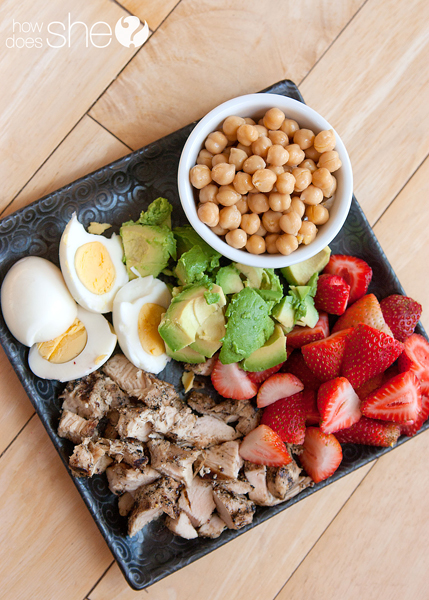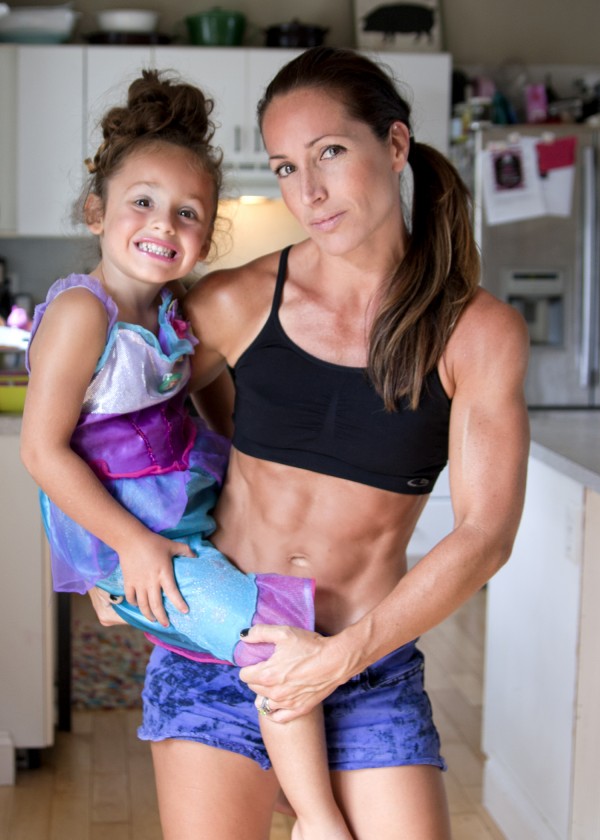We are thrilled to welcome back Jen Senecal who is here to share 10 tips for getting our kids excited about clean eating. And, hey, they just might excite you, too! Take it away, Jen!
How to Get Your Kids to Eat Carrots
There’s a lot of talk nowadays about how to eat clean and make healthy food choices for adults, but what about our kids? How do we get them to eat the same way? What do we do to encourage them to grab an apple over a donut? (Unless, of course, that donut is maple frosted.)
I feel blessed that my three daughters will eat just about anything put in front of them. I know that it partially depends on your child from the start, but I like to think that some of it comes from the food patterns we’ve created for them. While I’m not a nutritionist or expert, I’m sharing some of the tips and tricks that have worked for our family, in getting everyone on board with healthy eating.
-
Let them eat off your plate. I know, I know. This goes against all kinds of parenting rules of proper manners. I’m not saying that you should always let your children take over your food, but if you’re eating a fantastic salad and they’re eyeballing it, offer them a bite (or 10). I’m a salad junkie and over the last 10 months, I’ve made countless creations with all kinds of great veggies on top, and by letting my girls constantly eat bites off my plate every day, they’ve learned to love salad and now ask for their own.
-
Talk about your food. Instead of telling your kids that broccoli is good for them, tell them why it’s good for them, in kid terms. Simple things like, “Broccoli is a super healthy veggie that will make you stronger and help you kick that ball harder at soccer practice this weekend,” or, “Eating those carrots will make your hair so shiny and your eyes working well so you can read all those books you love,” give them an idea of what good foods can do for them. Even if you have no idea what they do exactly, give them an example that relates to their life in some way, and maybe they’ll be more apt to try it out.
-
Lead by example. I know this is somewhat cliché, but creating good food patterns starts with you. A lot of kids want to be like their parents. If they see you doing something consistently, they are more willing to try it. This starts with not making separate meals for you and your children. If you know that there might be some hesitation with a meal you plan to make, make it anyway and be sure to include a side that you know they will eat. This way, they don’t boycott the entire meal, but are continuously exposed to the food you prefer them to eat. If you want them to eat grilled chicken at lunch, don’t make them grilled cheese while you eat the chicken. Eat with your kids and eat the same types of foods. We follow this for both lunches and dinners and also when we’re out at a restaurant. Instead of ordering off a kids’ menu, we order their food from the main menu. They think it’s cool to get a steak and veggies off the “adult” menu rather than chicken fingers and fries from the kids’ one. Eating the same types of foods as a family really reinforces healthy eating habits (as long as you’re making healthy choices). Of course, I’m not saying that you can’t ever eat different foods than your kids, but it’s helpful to keep it consistent if you’re trying to develop good eating habits in order for them to make solid choices on their own.
4. Make it visually pleasing. This doesn’t mean you have to construct Pinterest-worthy sculptures out of every bite (although I have some seriously crafty friends who I give props to for making a pancake look like Picasso piece), but make it look like something kids want to eat. Make it colorful. Make it spatial. Throw some simple shapes or structures in. One of my favorite things to do is to “kabob” things. I take cherry tomatoes and mini mozzarella balls and skewer them on a toothpick. Or do the same with grapes and balls of melon (or anything you can fit on a toothpick). If you have a cookie cutter, shape out watermelon or a piece of toast that has honey and cinnamon on it. Make a rainbow of fruits and veggies on a plate. They say we eat with our eyes first, so find a simple way to present food that might be a challenge otherwise.
5. Make it FUN. One of my favorite things to do with my girls for lunch is to have a living room picnic or play “restaurant.” We set up a blanket on the floor and I fill a large platter with all sorts of things from fruit to veggies to chicken to beans to olives and more and we picnic on the floor together. Or I’ll set the girls up at their little art table and pretend I’m their waitress, giving them a list of what’s on the “menu” for the day while taking their orders. When I head back to deliver their meals, I always yell, “Order up!” and they not only get a kick out of it, but eat their food because they chose it.
6. Use words they like and create food in shapes they want. I might catch some flack for this one, but I’ve found that when you make carrot “fries” or sweet potato “chips,” my girls think they’re getting a treat (albeit, a healthy one). Changing the shape of your veggies into something that might be more relatable to them, even if that relatable shape isn’t typically a healthy one, works. As long as you continue to talk to your kids about food (like in #2 above), they’ll understand the differences of potato chips and kale chips. But a chip is a chip when they hear it and it can’t hurt to give it a whirl.
7. Let them help prep. This used to be tough for the Virgo control-freak inside of me, but once I got over myself and started asking the girls to help me with some of the prep, their palettes took an instant expansion. I make up little games while I chop, like, “One for the bowl, one for me, one for you,” where I’d take a bite out of whatever I was cutting up and give them one to eat, too. Aside from the healthy snacking they’ll do as they help you prepare your food, they are more likely to want to try to eat something they helped to make. (Especially cookies. Just kidding. Not really.)
8. Bring them shopping with you. I know this is like saying, “stab yourself in the eye,” but bringing your kids along to the market doesn’t always have to be a daunting task. Ask them to help pick out and store your items in the carriage. Give them a choice between two items that you want to buy and let them make the decision. Give them your list (or have them write it out on their own) and let them mark off the items as you get them. Ask what they think you should do with those brussel sprouts for dinner. Have them chat with the fishmonger or butcher about their favorite way to eat fish or steak. And, if you’re brave enough, bring along a little carriage for them to push around, next to you. The more involved your kids are in the entire process of buying, making and eating healthy foods, the more they’ll absorb the information and make healthy choices on their own.
9. Give them smoothies. If you have a tough time with a super picky eater, try making a fruit/veggie/yogurt/nut (if no allergies) smoothie for them. It’s a great way to load nutrients into a “meal,” and once they start having them more often, you could try to give them individual food items that are in the smoothies and tell them that’s what’s inside the smoothies they love so much.
10. Roast your veggies. While raw or steamed veggies are the very best at keeping every single nutrient alive inside of them, roasting vegetables brings out a sweetness that you can’t get any other way. I’ll admit that I was never a steamed broccoli eater. Neither were my kids. But once I started roasting them to give them that slightly crisped golden exterior, a bowl of them couldn’t last at our dinner table for more than 5 minutes. Now, I have to buy 6 heads of fresh broccoli for just one meal, when I make it this way. Roasting any veggie with a little bit of olive oil or coconut oil and some sea salt makes them taste like candy. When it doubt, throw it in the oven!
I think it’s also important to let your children have treats and snacks. For them to learn about balance and nutrition in a positive way and not get caught up in any kind of “rules.” For them not to grow up being afraid to eat a piece of bread. So while we try to enforce healthy eating habits, we don’t obsess over food with them. We don’t tell them that they can’t eat anything. Because that will just backfire on us in the long run, and I’m already sweating the future years of having three girls in high school at the same time. I don’t need any added pressure.
If you have any great tips on getting your kids to eat healthy, please comment below and share!
Jen Senecal is a mom to 3 young girls and the co-founder of fitness
blog, The F Word, where she and her blog partner, Kelly, share
workouts, recipes, fitness fashion, inspiration, tips and more. She
is a contributing blogger, feature writer and fitness columnist for
Providence Media magazines. Jen is also the co-founder of an
award-winning local deals, fashion, events and giveaway site, Rhody
Mamas, and is a member of the Rhody Bloggers and Rhody Blogger
for Good communities. A graphic designer, photography enthusiast,
fitness fanatic and former Conde Nast mom-advisor, Jen lives with
her family in Rhode Island, eats popcorn once a week, and looks
forward to the day when DVR can record more than two shows at a
time.






Theresa says
Would you post a link to Jen’s website, I cannot find it through blogloving. Thank you!
jen senecal says
Hi Theresa! Thanks so much for asking. Our website is http://www.thefwordblog.com. Appreciate the support! – Jen 🙂
Stephanie says
Love it! #2 is an especially great reminder that I don’t emphasize enough.
jen senecal says
I never realized how effective it is until I heard my daughter telling my other daughter what kinds of great things will happen if she eats her spinach, one night. They truly do listen and remember. Now, i try to give real examples for them whenever I can. Even at their young age, they realize what a treat is versus what real, healthful food is. Kids are simple creatures that sometimes listen to their parents. LOL. Thanks so much for the comment!!! – Jen 🙂
What is corn syrup says
Better question is, how to avoid corn syrup? Especially for kids, they cry until they get what they want. The healthier stuff doesnt have such good packaging, they don’t want it.
jen senecal says
The best way to avoid corn syrup is just to not buy anything that has it in it. I try really hard to keep it out of my house, so there are no options for the kiddos (or myself) to go snack on. Eventually, if you keep the foods you want them to eat around, and those foods only, they’ll start eating them. They have to get hungry at some point, right? LOL. 🙂
Heather @ Kraus House Mom says
My kids love when I give them a whole bunch of stuff for lunch, they call it Bon Appetite and they love “burnt salad” which is actually roasted vegetables.
jen senecal says
Heather- our kids are so much alike. Love it.
Netty says
Bring them shopping with you. I know this is like saying, “stab yourself in the eye,”
hahahahahahahaaha!!!! 🙂
Dottie Bee says
I would add giving them a garden to this list. My son is an insanely picky eater that only wanted to eat, “white and orange” things. Growing and preparing vegetables was the thing that got him to really turn a corner on veggies.
Misty says
Oh my goodness I have drafted a post with tips on getting kids to eat their veggies almost identical to yours and am just getting ready to post it on my blog! I hear many of my friends say “well my kid just won’t eat that” and I know so many parents struggle in getting their kids to eat anything healthy which is why I also wanted to offer some helps. Yours is very well written and I agree with everything you’ve said! 🙂
Karen says
My kids don’t like anything.. nothing. Its partly from being at their dads 50/50, he has created unhealthy eating habits there that make them not want to eat when they are at my house. They have never really liked fruit or veggies, they do eat some green veggies but that’s about the extent of their nutrients. I’m at a loss, and they are old enough to know better (twins, 12 years old)
Jeanne Kolb says
Jen,
Great post! Just finished my 29th year of teaching and am always looking for good tips to pass on to kids/ parents!
Looking forward to more of your ideas:)